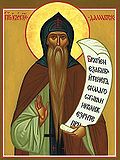Top Qs
Timeline
Chat
Perspective
May 30 (Eastern Orthodox liturgics)
From Wikipedia, the free encyclopedia
Remove ads
May 29 - Eastern Orthodox Church calendar - May 31
This article needs editing to comply with Wikipedia's Manual of Style. In particular, it has problems with using bold text for emphasis - see MOS:NOBOLD. (May 2019) |

All fixed commemorations below celebrated on June 12 by Orthodox Churches on the Old Calendar.[note 1]
For May 30th, Orthodox Churches on the Old Calendar commemorate the Saints listed on May 17.
Remove ads
Saints
- Martyrs Aphrodisius, Agapius, Eusebios, Charalampos and Christina, in Nicomedia, by fire (65)[1][note 2] (see also April 28 - West)
- Hieromartyr Eutychius, disciple of St. John the Theologian (1st century)[3] (see also August 24)
- Martyrs Romanos and Teletios, in Nicomedia, by the sword.[4]
- Martyr Euplius (Efplos).[5]
- Martyr Natalios, by the sword.[6]
- Venerable Martyr Barlaam, of Caesarea in Cappadocia (c. 303–305)[7][8]
- Saint Cyprian of Antioch, reposed in peace.[9]
- Saint Macrina the Elder, grandmother of St. Basil the Great (340)[10][11]
- Saint Emmelia of Caesarea, mother of Saint Basil the Great (375)[12] (see also January 1 )
- Venerable Isaac the Confessor, founder of the Dalmatian Monastery at Constantinople (383)[10][13][14]
Remove ads
Pre-Schism Western saints
- Martyrs Gabinus and Crispulus, at Torres in Sardinia, Protomartyrs of Sardinia (130)[15][16]
- Pope Saint Felix I, who was the first to condemn the heresy of Paul of Samosata (274)[15][16]
- Saint Venantius of Gaul, elder brother of St Honoratus of Lérins (374)[10][15][17][note 3]
- Saint Exuperantius (Esuperantio), Bishop of Ravenna and Confessor (418)[15][16]
- Saint Madelgisilus, Irish saint, disciple of St Fursey (655)[15][note 4]
- Saint Anastasius of Pavia (680)[15][16]
- Saint Hubert (Hugbert of Bretigny, Hubert of Maastricht), the "Apostle of the Ardennes", first Bishop of Liège (727)[10][15]
- Saint Gamo, monk and then Abbot of Brétigny near Noyon in France (8th century)[15]
- Saint Walstan, a farm labourer in Taverham and Costessey, remarkable for his charity (1016)[15]
Remove ads
Post-Schism Orthodox saints
- Saint James, monk of Starotorzhok in Galich, Kostroma (15th-16th century)[10]
- Venerables Isaiah and Nikanor of Arkhangel'sk (16th-17th century)[11][18][note 5]
New martyrs and confessors
Other commemorations
Icon gallery
- Venerable Isaac the Confessor, founder of the Dalmatian Monastery at Constantinople.
- St. Aphrodisius.
- Pope Felix I (269 - 274), Fresco in Sistine Chapel, Vatican.
- St. Hubert, the "Apostle of the Ardennes", first Bishop of Liège.
- St. Walstan (from the rood screen at St Andrew's Church, Great Ryburgh, Norfolk).
Remove ads
Notes
- The notation Old Style or (OS) is sometimes used to indicate a date in the Julian Calendar (which is used by churches on the "Old Calendar").
The notation New Style or (NS), indicates a date in the Revised Julian calendar (which is used by churches on the "New Calendar"). - "[Roman, Gallican and Spanish Martyrologies. Ado, Usuardus, and Notker.]"
- "S. APHRODISIUS and his companions have met with a very remarkable fate. The Martyrologies mention Aphrodisius, Carilippus, Agapitus, Eusebius, Malina, and others, as martyrs, and some add, at Tarsus, in Cilicia. But at Béziers, in France, S. Aphrodisius is venerated on this day as the first bishop of the see; and a strange story is told of him. He is said to have been an Egyptian, who received SS. Mary, Joseph, and the infant Saviour, into his house on the occasion of the flight into Egypt. And when he heard of the miracles and death and resurrection of Christ, he was converted, and went and joined himself to the Apostles, and received the Holy Ghost along with them on the day of Pentecost. Then he was appointed bishop under S. Peter, and travelled with him. Afterwards he went with Sergius Paulus to Gaul; Sergius Paulus became first bishop of Narbonne, and Aphrodisius first bishop of Beziers, by the appointment of S. Paul, the apostle of the Gentiles. And there he suffered martyrdom with his companions, Carilippus, or Ciryppius, Agapius and Eusebius.
- But as Henschenius has shewn, this story is made up of scraps of legendary matter from various sources, of absolutely no authority. This is not all. On the strength of the place of martyrdom of these saints not being inserted in some Martyrologies, the forger of the Chronicle of Flavius Dexter in the 16th cent. set them all down as having suffered at Capana, in Portugal, in the year 76. Relying on the impudent forgery of Higuera, in 1651, De Arze Reynoso, B. of Plasencia, in whose diocese Capana was, obtained authority from the Holy See to solemnize the festival of these saints, as a double with proper office, and indulgences for forty days to all who should assist at the offices, and pray for the extirpation of heresy and peace between Christian princes. S. Aphrodisius is represented at Bourges with his head in his hands."[2]
- After living as hermit on an island near Cannes, both travelled to the East to learn the monastic life. Saint Venantius reposed in peace in Greece.
- After some years of monastic life at St Riquier in France, he went to live as a hermit with St Pulgan near Monstrelet.
- This feast is described in Patmos Codex 266.
Remove ads
References
Sources
Wikiwand - on
Seamless Wikipedia browsing. On steroids.
Remove ads






